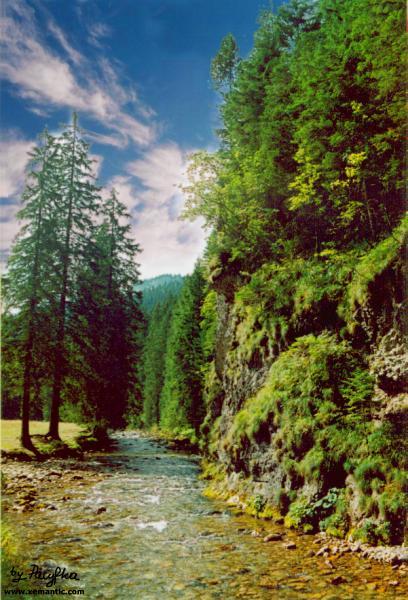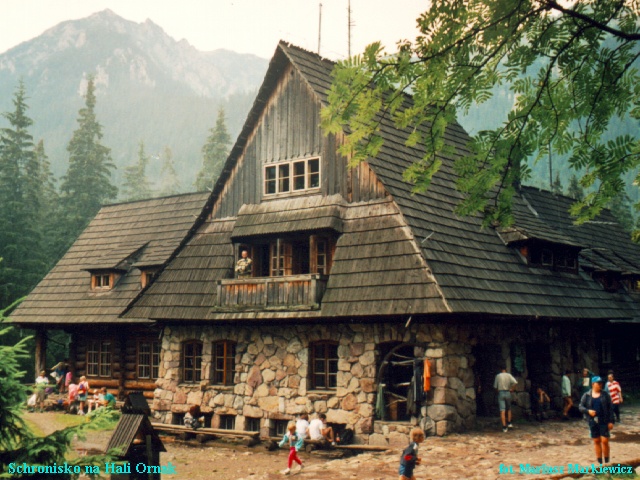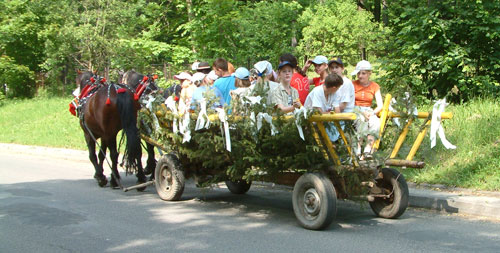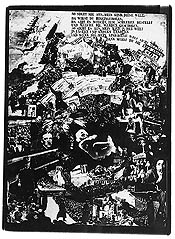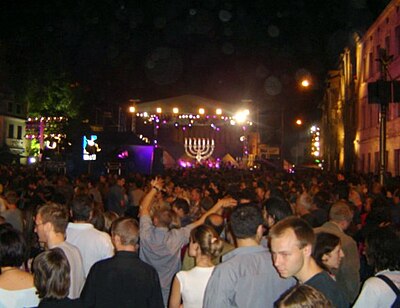
[The Jewish Festival in Krakow (from two years ago)]
I had an amazing dinner experience last night.
I decided to take a stroll through Kazimierz and see if I could get a ticket for the tour of the Jewish Quarter on Sunday, but the festival office had already closed for the evening. I ran into two Americans from Fresno who were wondering what the festival was. I showed them the posted schedule and explained (briefly, I assure you) what klezmer music is. "Jewish jazz," he said, "that sounds interesting." They asked about where they could eat, so we walked half a block to the main square where the concert will be, which is ringed with cafes. They only had a room for last night (they told me that they had lived very planned lives and decided that this trip they will simply go from day to day), so I showed them on their map where the hostels were listed.
Then I headed over to the Klezmer Hois to see if they had any dinner-type foods, or just coffee and cake. The outside tables were full, and there was only one free inside table, but it was for 8. I saw two guys sitting at a table with a menu, so I asked if I could see. "Sure," the older one said in a distinct Israeli accent. I looked through the menu and the food looked good. I asked him in Hebrew where he was from. His name is Haim Maor, and he's a professor of art and art history at Ben Gurion University in the Negev, and the younger man with him is Rafal Jakubowicz, and is a doctoral student in art from Poznan University, but he also spoke Hebrew. It turned out that the program that brought the professor to Poland provided him with the grad student to act as translator during his trip.
They invited me to join them so I happily said yes. We ordered food and wine (I decided to order hot, spiced wine), but before we drank he said, let's remember it's yom sheshe (Friday), so he put on a kipa and I got mine out of my pocket and we did the bracha over the wine. Then it was back to chatting.
I wish I could remember even a fraction of the conversation; it was wide ranging and covered topics such as art, memory, the Holocaust, resurgent fascism, Israeli artists and museums, Walter Benjamin (who, I shamefully admitted, I had only read a few fragments of), James Joyce, and a post-modern scholar whose name I have totally forgotten. Some of the conversation was in Hebrew and some in English. This was the most Hebrew I've spoken in quite a while.
One story I do remember is Dr. Maor telling me about a friend of his who does social therapy (?). He works with the children of survivors and the children of perpetrators and brings them together to talk to each other. We had been talking about the problem of reconciliation. He told me that his friend had met the son of Martin Bormann, Hitler's head of the Nazi party chancellery. For a long time, no one was sure what happened to Bormann at the end of the war, but it is now been shown he died in the fall of Berlin.
Bormann's son didn't know about who his father was until he was older. He reacted to the news by deciding to become a priest. He was stationed in a country in Africa when one day he was called to the home of a dying man. The man, who had been a German soldier during WWII, asked Bormann (not knowing who he was, of course), for help. During the battle of the Warsaw Ghetto, he told the priest, he had captured a young Jewish girl who was leaving a bunker. His commanding officer told him to shoot her. He didn't want to, he said, but he did as he was told. Now, every night in the dark, he saw her eyes at that last moment, asking him why he was shooting her. Help me not to see the eyes, he asked the priest.
I said that I thought a lot of Nazis didn't have any guilt over what they did, but he said that might be true of the committed ideologues, but not of the everyday people who went along.
The food was very good. Given my past experiences in Poland, I ordered the duck with apples, and it was nice and crispy (the skin that is). They moved us all to an outside table, to make room for a really big group, and we said that they should comp us with free desserts and the waitress sort of agreed. We ended up ordering three desserts (chocolate cake, walnut cake, and my choice, the "Klezmer torte"). The chocolate cake, we all agreed, ended up being a bit too heavy, and the walnut cake was pretty good, but the klezmer cake -- layers of chocolate mousse, whipped cream, with some cherries (sort of a black forest-type deal).
When it came time to pay the bill, we asked the Polish student to remind the waiter about the "deal" with the desserts, but he chickened out. We split the bill three ways equally, which came to about 80 zloty a person; a little pricey ($25), but still well under the most expensive meal I ever had in Poland (twice that amount for duck in Rzeszow last year). And considering we had a wonderful chat for about 2.5 hours, a bargain.
After that we all wandered down to Plac Nowy to hear the open-air klezmer concert. They were only in Krakow for the one night (the professor had spent the day at the archives in Auschwitz looking up documents on his father), and only happened to be here by chance. He was amazed at the reaction of the Poles to the klezmer music. I talked about my theory that the Poles are romanticizing the Jewish past to find a liberal, diverse image for their future. He referred to Freud's theory of the return of the repressed.
After the klezmer group on the roof of the market finished their set, I wished them well and headed back to the hostel.
Yesterday I was worried about sharing a room with three other guy: when would they come back? how loud would they be? etc.
Everything turned out great. I went to sleep early since I had to be up early and I wasn't sure how much sleep I would get. I woke up at 5 am when the sun came up and found that I had slept the night in the room by myself. I took a shower and got dressed. As I was walking out the door to get breakfast, the other two guys came in after a night of drinking, so it looks like I dodged a second bullet.
At breakfast I watched the late-night partyers arrive, still drunk, and giggling over their toast and alcohol-induced exploits.
So I get to the train station this morning, and who is there but Dr. Maor and his graduate student translator. I asked them how they slept, and he said not very well. There was so much noise from the bars in Kazimierz that he didn't fall asleep til 4;30. He figured he got no more than 2 hours sleep last night.
I didn't see them on the train, but just read the paper. I managed (with some difficulty) to get the museum of the Warsaw Rising. Most non-Poles know nothing about this event, and often confuse it with the Warsaw Ghetto Uprising. This was a year later and involved the Home Army rising up in revolt against the Germans with Soviet troops just across the river. The idea was to liberate the capital so an independent Poland could be formed, rather than the Stalinist state the Soviets intended.
Stalin reacted by halting his advance and the British and the Soviets basically turned their backs while the Germans leveled Warsaw to the ground. After two months of fighting 87% of the city was in ruins, with over 100,000 civilians dead. The Germans than marched the surviving population to internment and concentration camps and blew up any important buildings that had survived. Only then did the Soviets resume their advance. Any surviving Home Army fighters they found, they arrested and sent to Siberia.
For 45 years, Poles were not permitted to commemorate the sacrifices of the Warsaw Rising of 1944. In 2005, this museum in Warsaw was opened, and it was important for my research for me to visit it. I spent a lot of time frantically scribbling down the texts posted on the walls concerning Jews and the Holocaust, as well as making notes about what Marek Edelman, the surviving member of the Ghetto fighting force, had to say about Jewish participation in the Warsaw Rising. Over lunch, I transcribed my notes into a (mostly) legible form.
Then I headed out for a late lunch of pasta. Not bad, and then I went to Cafe Blikle for a dessert.

[Cafe Blikle in Warsaw]
This sweet shop dates back to the 19th century, and was particularly popular with Charles de Gaulle, when he lived her in the 1920s. Despite that last fact, I decided to check it out. I chose a chocolate cake, which turned out to be thin layers of chocolate cake soaked in rum, separated by chocolate mousse. Very tasty. Then it was back to Krakow. Being in Warsaw really brought home to me how much more beautiful Krakow is, and how much I prefer the hills of Galicia to the plains of Mazovia.
On the train I got into a conversation with a Polish man who asked me about my visit to the Warsaw Rising Museum (he could see the materials I had brought with me). I talked about my experiences in the museum and why I went and we talked about the Holocaust in Poland and about Jewish groups who come to Poland but don't meet with Poles. I told him how that was exactly the sort of thing I was trying to avoid.
By the time we got to Krakow, it started to rain. It was a brief storm, but it did dampen turn out at the closing festival in Kazimierz. My impression is that turnout was down about 25% over last year. I heard several groups including rap-inspired klezmer and cuban-inspired klezmer. I stayed for about 2.5 hours and then headed back to the hostel. I found myself wondering how the ghosts of Jews who lived in Kazimierz 60 years ago would react to the music and the festival. Would they recognize any of it? I don't think so.
Anyway, there are so many people milling about the reception desk where the computer is right now that I can't think to type so I'm going to log off til tomorrow.










